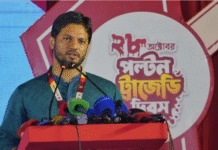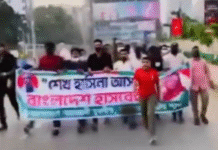Awami Violent League (Part-1)

Political clashes in Bangladesh have never been a new thing. Since the independence of Bangladesh, hundreds of thousands of people were killed brutally or fell victims to the brutality of such clashes.
But the most interesting thing about these clashes is that Awami League party has always been the name on the fore. The leaders and activists of the party have clashed on the issues like establishing supremacy, clearing ways for future progress, making a fortune and so on. Surprisingly, they have always been in conflicts no matter they are on the ruling side or not.
The student front of the party, Bangladesh Chhatra League, has made the headlines the most through engaging in clashes sometimes within their own party, sometimes by killing the members of opposition groups.
The recent statistics can elaborate it further.
A report by UK government on Bangladesh namely, “Country Information and Guidance Bangladesh: Opposition to the government,” states:
In 2016 alone, according to local human rights group Ain O Salish Kendra, at least 13 leaders and activists of Awami League and its associated organisations were killed, and 961 were injured in 96 incidents of internal clashes between January and August.
Muting The Dissenters
Awami League has never been so tolerant about dissenting opinion, and it has always been evident in their activities.
In an article in The New York Times, published on June 11, 1973, the newspaper estimated that the political murders had crossed the 2000 mark. The article stated, Independent sources say that the 2,000 figure seems accurate as almost daily now the murder of several Awami League workers is disclosed in
During that time, Awami League used to fight with three fronts- Jatiya Rakkhi Bahini, Lal Bahini and Shecchashebok Bahini. All these groups were used to suppress the opposition groups and sometimes rivals in their own party.
Among the prominent politicians killed by Awami League were, Jasad Vice-President Mosharraf Hossain, Jasad supported Krishak League leader Siddiq Master, Manikganj Jasad Joint Secretary Sadat Hossain Badal, and Jahangirnagar University Central Students’ Union General Secretary Borhanuddin Rokon.
Awami League men continued the campaign of terror in the following decades.

The same Akhtaruzzaman Chowdhury on August 27 of 1999 declared himself the new chairman of the United Commercial Bank Limited forcing the directors to submit their resignations at gunpoint after assaulting them with hired thugs. Some 40 armed men led by him stormed the bank’s headquarters in Dhaka that day and forced their way into the boardroom, where the directors were meeting.
On February 13, 2001, four persons including a policeman were killed and four others wounded during a hartal when activists of the then ruling Awami League led by Dr HBM Iqbal opened fire on the opposition party men in a procession at the city’s Malibagh. Following the incident, BNP leader Moazzem Hossain Alal on the day filed a case with Motijheel Police Station against more than 150 people including Iqbal for killing three BNP activists.

Awami League activists on October 9, 2010, beat to death Sanaullah Noor Babu, BNP-backed chairman of Boraigram Upazila, during a BNP procession in Bonpara Bazar, Natore.
Around 50 Awami League activists equipped with firearms, sticks, iron rods and machetes swooped on the BNP procession and started beating the opposition men leaving many severely injured.
The attackers then caught Babu and beat him indiscriminately. Babu received severe head injuries, and there were cuts on the hands and legs and beating marks all over the body.

At least seven people, including three with the bullet, were injured in a clash between law enforcers and supporters of a ruling Awami League-backed Upazila chairman candidate at Kashua village in Chandnaish Upazila.
Alleged Awami League men stabbed a Shibir activist dead as the latter was going to a voting centre in Bagerhat Sadar . Deceased Manzarul Islam, 21, was a shathi member of Shibir. Hailing from Tengrakhali village in Kachua Upazila, he was an honours second year student of Economic Department in Bagerhat Govt PC College. He came under attack around 9:00am while he was going to Karapara Union Parishad Office voting centre.
Killing Friends
Though the Awami League as a party has engaged in a clash in every single party in Bangladesh since independence, they have fought with their own party men to seek revenge, for making a fortune or to establish supremacy over rival groups.
The much-talked-about killing of seven students took place in Mohsin Hall on April 4, 1974. The then General Secretary of pro-Awami League student group Chhatra League, Shafiul Alam Prodhan’s supporters killed seven students on a trivial reason in the Mohsin Hall of the University of Dhaka. They were the follower of a central leader namely Abdur Razzaq who later rebuked the killers saying, “Why did you kill them in the campus area? You should have done it Savar (outskirt of Dhaka) and dumped them there.”
In 1974, the bodies of four students were found at a place between Jagannath Hall and Shamsunnahar Hall. Besides, the bodies of four outsiders were found on the campus. A journalist who saw the killing of these four later wrote the incident in a daily. The government sacked her for the ‘courage’ she showed.
Even after the party was thrown off from the power in 1975, Awami League cadres kept fighting. Clashes between activists of two groups of Chhatra League claimed the lives of top leader Luku and two of his associates in 1977. Luku was slaughtered near Kataban Market. Two students named Honu and Gopal were killed in 1977.
Rontu, the brother of another leader Hemayetullah Auronga, was killed allegedly by the cadres of Noor Group the same year.
On January 9, 1992, DU unit Chhatra League Organising Secretary Moniruzzman Badal was shot dead in front of Shamsunnahar Hall. Chhatra League activist Tanoy was killed in front of Curzon Hall on July 11 the same year.
On September 1, 1994, a BCL activist named Bulbul was shot dead during an intra-party clash.
In 1996 after arriving power again after 21 years, a student of Dhaka University’s Jagannath Hall was killed in an intra-party clash of Bangladesh Chhatra League.
In 1998 on April 23, BCL leader Partha Pratim Acharya was killed in an internal clash of the party. Another BCL activist of Jagannath Hall unit was killed in an intra-party clash the same year. His name could not be identified.
Two students — Monir Hossain and Firoz — were killed in different clashes in 1999. However, cases filed over the incidents never came to trial.
Five activists of Bangladesh Chhatra League (BCL), the student wing of Awami League (AL), were injured in a factional clash at Salimullah Muslim (SM) Hall of Dhaka University (DU) on October 26, 2008.
Of them, two activists Saikat and Shafin were critically injured and rushed to Dhaka Medical College and Hospital. Later, Saikat was shifted to Orthopedic Hospital in the city. Sources said Sumon and his group attacked Saikat and his men with iron rods, wood sticks and machete in front of the hall gate at around 7.00pm.
Sumon, an alleged fake student of the University, and his men brutally beat Saikat with a machete.
They cut the veins of Saikat’s leg and left hand with a machete, sources added.
Source: Daily BD Times 04/07/2017









